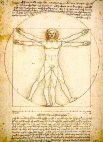

The idea: you can measure with your body.
Length, angle, time, etc. This page deals with length.
And... you will never forget to bring your bodyruler with you. :)
Though sometimes I forget my calibration...
Many body distances can be used as measures, but you dont need all of them. Many have similar size (for example, hand and palm), so you can just choose ones you prefer, perhaps ones with numbers easier to remember. Also, some are related (1 palm can be 4 fingers). Feel free to use other measures, or to modify these (like using little finger rather than middle finger). The important thing is consistency, using them the same way each time.
Before using any new measuring instrument, one needs to calibrate it by comparing it with something else, something of known measure. For your bodyruler, you can use an "ordinary ruler". Averaging can be used to reduce error. For instance, measure out 3 palms and divide by 3, rather than just measuring a single palm.
Here are some measures you might use. I've highlighted my favorites, and included some roman names.
| Measure | Explanation | my personal calibration
Your's will differ. |
| finger | finger width (digitus) | 2 cm, 3/4 in |
| "nail" | width of thumb's nail. (It's about finger width.) ("nail" historically also names some longer units.) |
1.5 cm, 5/8 in |
| inch | thumb width, "mesouret at the rut of the nayll" | 2.5 cm, 1 in |
| half finger | fingertip to (middle of) second joint (choose a finger (historically, it was middle)) |
5.5 cm, 2 1/8 in |
| finger length | fingertip to knuckle | 11 cm, 4 1/4 in |
| palm | width of 4 extended fingers (palmus)
("palm" is also know as "hand".) |
7 cm, 2 3/4 in (at middle joint)
8 cm, 3 in (at knuckles) |
| hand length | hand length, heel to fingertip | 19 cm, 7.5 in |
| hand span | hand width, from outspread thumb to little-finger (Convenient, but because stretch varies, a bit less consistent than these others.) |
22 cm, 8.5 in |
| foot | foot length, heel to toe (pes)
Good for walking short distances. |
27 cm, 10.5 in (bare)
30 cm, 12 in (sneakers) |
| cubit | elbow to fingertip (cubitus) | 47 cm, 18.5 in (~0.5 meter) |
| yard | nose to fingertip, with arm straight out to side, head facing front
Good for measuring rope and fabric. |
92 cm, 36 in (3 ft)
(1 meter if I turn my head) |
| fathom | fingertip to fingertip, arms out stretched | 178 cm, 68 in |
| height | the usual | 182 cm, 72 in |
| step | one step | ~80 cm, ~30 in (~3 ft) |
| pace | two steps (passus)
Good for walking long distances. |
~150 cm, ~60 in (~1.5 meter) |
It would be nice to discuss measurement error and techniques, usage hints, historical notes on the units, averaging to create standards, perhaps also calibrate precision/errorbars, ...
The visual height of your fist, held out in front of you, is about 10 degrees.
You can check this by starting with your arm straight out, and than walking you fists upward, hand over hand. At 9 fists, you should be pointed at the ceiling.
+
+ f
+ f
Eye ddddddddddddddddd f +
A brief elaboration: together, the distance from eye to outstretched
fist, and the height of the fist, form two sides of a right triangle,
and thus determine an angle. (say 58 cm and 9 cm, "opposite over
adjacent" is 9/58, with arctan(9/58) = 9 degrees).
It would be nice to have some notes on usage, on sensitivity to fist distance, on measuring the distance to objects of known size (aircraft, people), on measuring the height of a building by walking towards it, on ...
History:
1997.May.05 Added link to A View from the Back of the Envelope.
1997.Mar.25 Added "hand span", and "measuring distance w thumb" link.
There has been no comment, and thus no further work here.
1996.Dec.17 Fleshed out draft.
1996.Dec Occasional puttering.